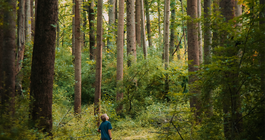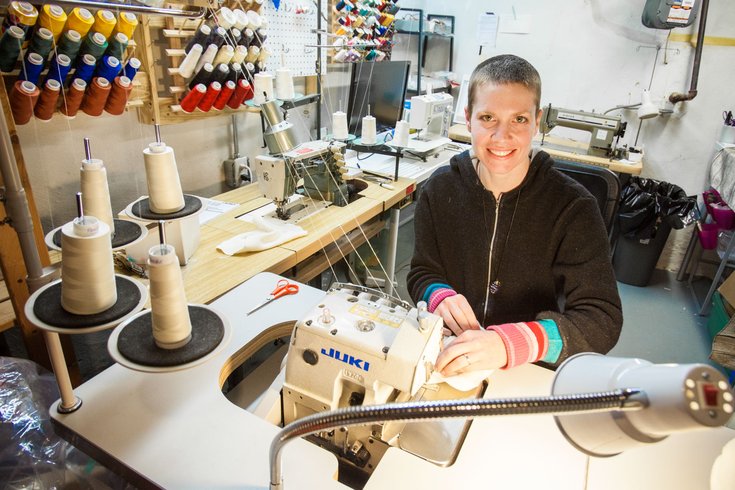
May 01, 2015
 Thom Carroll/PhillyVoice
Thom Carroll/PhillyVoice
Marni Duffy uses an industrial overlock machine to sew the edges of hemp and organic cotton washcloths.
Pregnant with her third child and about to graduate with a bachelor's degree in physics, Marni Duffy's physics adviser at Temple University sat her down and unleashed the frightening tale of how she returned to research and teaching two days after giving birth.
At that moment, Duffy knew physics just wasn't her thing.
Not wanting to miss any more of her kids' upbringing than she had to, she rethought her career. As a side project, she'd already been sewing and selling wool pants and diapers, ones she'd repurpose out of sweaters purchased from thrift stores. In 2008, as sales picked up alongside her confidence, she went full steam ahead with the idea of a cloth diaper business. She began selling diapers -- made from a combination of organic cotton, hemp and bamboo -- on consignment at The Nesting House. She now sells wholesale, under the brand Rebourne, to The Nesting House (which has locations in Collingswood, Camden County, and West Mt. Airy), CLOTH in East Passyunk, City Sprouts in Kensington and The Crunchy Bean in Alabama. (In addition to her own online stores.)
Below, Duffy explains cloth diapering, who her favorite Philly mom is and, of course, what she's up to this weekend.
How do you cloth diaper? You navigate through the overwhelming world of cloth diapers until you choose a brand or three. You buy cloth diapers for your baby, which come in different styles and sizes. You change the baby when they are wet or have soiled the diaper. Depending on the system you're using, you replace the entire thing or you just put a clean diaper on and potentially reuse the cover if it's not soiled. There are many washing techniques and schools of thought on detergents, using bleach, using a dryer, soaking, etc. With the wool products I make, they are all hand-wash and lay-flat-to-dry only. The diapers get washed in a machine and either hung to dry or put in a dryer.
How many diapers do you need, if you're using cloth? Forty dollars probably sounds steep to the casual observer.
For each stage, I recommend between 18-36 diapers per child. If you're using wool, you only need about four to eight wool covers. My diapers are on the highest end of the spectrum in terms of cost because of a few factors, but namely, materials: I only use organic fibers, and I am careful about the factory conditions of the fabrics I purchase. I follow FTC (Federal Trade Commission) and CPSC (Consumer Product Safety Commission) guidelines, and all of my products are made from materials that are lead- and phthalate-free and, when necessary, are tested for flammability. Many cloth diaper companies have started up in the last few years, and if you are buying a new cloth diaper for $3.50, you are getting what you pay for -- with regards to the people producing the fibers, the ground growing the fibers, the people sewing the diapers, the people packaging and shipping the items from overseas and the testing being done to the items to be sure they are safe for your baby.
The 'Woollie Wrap,' a two-layer wool cloth diaper made from recycled wool sweaters and merino wool interlock fabric. Megan Gray / PhillyVoice.com
What do you think makes for great cloth diaper design?
I think a really great cloth diaper design is initially one that is easy for anyone to figure out quickly. The diaper designs that have flourished and are more mainstream in the states are the all-in-one or pocket, one-size-fits-all designs. They are easy to learn, especially for those that have put a disposable on a baby. They grow with your baby, cutting down on the need for buying different sizes.
Unfortunately, many of the materials used in the popular diapers aren't great for our environment, both during production as well as after they are used and have to head to a landfill. They are also often hard to care for, as odors and stains are very difficult to get out of synthetic fibers, particularly microfiber. These are two of the reasons I love natural fibers: They are easier to clean and care for, retain less odor and will biodegrade in a landfill faster than synthetics. Another benefit of wool over synthetics as a diaper material is that it absorbs moisture and is a better nighttime solution for heavy-wetting babies. I try to find a harmony between ease of use and healthy fibers in my products, so that while the initial design/fabric may not seem the most user-friendly, they are truly more friendly along every step of the production chain, from the earth used to grow the organic cotton, to the hands and factories that create the fabric, to the sensitive skin of a baby, to the end placement in a landfill.
What Philadelphia mom inspires you?
My friend Dena Driscoll inspires me. Together, we organize Kidical Mass Philadelphia and try to encourage more families to get out on bikes for transportation. Our monthly rides go through Center City at a crazy rate of about 4 mph. We like to connect with local bike shops, our local bike advocacy group -- the Bicycle Coalition of Philadelphia -- and other local organizations for rides and events. We are excited to see how Indego Bike Share will make our rides even more accessible to [not just] families who have kids that have their own bikes, but parents that haven't been on bikes in a while.
What are your plans for the weekend?
I work part time at Firth & Wilson Transport Cycles, so this Friday, I will be hanging out for their First Friday party. After that, I'll be resting and hanging out with my kids as I'm recovering from surgery for skin cancer.